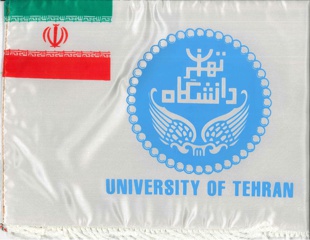
Last modified: 2019-10-14 by ian macdonald
Keywords: tehran university |
Links: FOTW homepage |
search |
disclaimer and copyright |
write us |
mirrors
![[Flag of Tehran University]](../images/i/ir_ut.gif) image by
Ivan Sache, 22 October 2018
image by
Ivan Sache, 22 October 2018See also:
This flag dates from the period since the creation of the Islamic Republic in
1979, as can be seen from the version of the Iranian National Flag used in this
institutional flag. The university was founded at the beginning of the 20th
Century, although it was not until the 1920s that it began to grow and develop.
Since the abolition of the name 'Persia', the university has undergone a number
of name changes; University of Teheran has remained more or less constant, but
the modifying adjectives have included Imperial, Pahlavi, Persian, and a number
of others.
Ron Lahav, 28 December 2008
The University of Tehran (UT), inaugurated in winter 1934, has its roots in
Dar-ol-Fonoon, the engineering school established in 1851 during the Qajar
dynasty. This was the first modern school in the country, founded by Chancellor
(Prime Minister) of Persia Amir Kabir (1848-1851) after a journey to Russia and
the Ottoman Empire. Engineering, medical and industrial sciences were initially
taught by seven Austrian professors.
UT manages seven campuses: Central,
Alborz, Fouman, Rezvanshahr, Jolfa (international), Kish (international),
Pakdash, Qom. It is composed of 9 Colleges, 45 Faculties and Schools, 133
Departments and more than 50 Research Centers.
http://ut.ac.ir/, UT website
The flag of UT is white with the
university's emblem in the center.
Photos
http://ut.ac.ir/en/news/3656/rector-of-university-of-indonesia-met-with-president-of-university-of-tehran
https://drfuturist.org/?p=148
http://ut.ac.ir/en/news/4148/the-second-round-of-iran-and-italy-cultural-dialogue-was-held-at-ut
The emblem of UT is based on a plaster plaque of the Sassanian period,
whose main characteristics are:
1. Wings and feathers in Sassanian art are
symbols of god Bahram (Mars); Sassanian kings, due to their aspiration to expand
the power of their divine splendor, needed the patronage of this god. Wing motif
besides being a symbol of Bahram can be a symbol of mythical Simurgh (phoenix)
and its significant role in Sassanian art. Moreover it is a symbol of bird and
ascending to heaven.
2. The circle is a symbol of sun and its surrounding
pearls being a symbol of harvest, are two of Mithra symbols frequently seen in
Sassanian art. In addition it is supposed to have a relation with Anahita, the
water goddess; motifs being placed inside this circle can be a symbol of divine
splendor which help the designer to gain the organizational points of the
university.
3. The short Pahlavi inscription placed above this Sassanian seal
which means excessive glory is similar to the way the word “Iran” is written.
There is also an apparent resemblance between the word of Tehran University
writing in the present logo and the plaster plaque.
M. Emami & M. Hessahi.
2015. The usage of ancient Sassanian heritage in emblem design. Case study:
Tehran University logo. Honar-Ha-Ye-Ziba (Honar-Ha-Ye-Tajassomi) [Journal of
Fine Arts (Visual Arts)] 20:3, 17-24.
https://www.sid.ir/En/Journal/ViewPaper.aspx?ID=540402 (English abstract)
Ivan Sache, 22 October 2018
 image located by Bill Garrison,
13 September 2019
image located by Bill Garrison,
13 September 2019